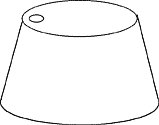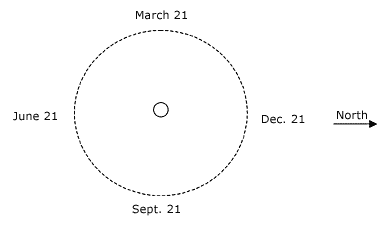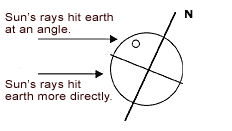|
About This Activity
Grade level:
5-8
Time: 45 minutes
Download this activity:
Word
|
PDF
See our
Teacher Tips
for standards, discussion ideas, and more.
|
Modeling the Seasons
by Lori Lambertson
Students model the seasons with their own earth globes
.
Materials
For the whole group, you will need:
• a 150 – 200 watt light bulb (not frosted) or a flashlight
• a lamp or socket for the bulb
• an extension cord
• a room that can be made dark
For each student or pair of students, you will need:
• a styrofoam ball
• a large straw
• a rubber band
• a flexible plastic cup (5.5 oz)
• scissors
• tape
• a thumbtack or sticky dot
• a protractor
• a ruler with centimeters
Making a Model of the Earth
Push the straw through the center of the styrofoam ball. This represents the axis about which the earth rotates. One end is north and the other end is south. Place a rubber band around the the center of the ball (the earth’s equator). Looking at a globe or a map, find your approximate latitude, and place the tack or dot there. (For example, San Francisco is at 37.75¾ north, so placing the tack not quite halfway between the equator and the North Pole is an acceptable approximation.) Use the scissors to make a hole in the bottom of the plastic cup, near the side, as shown. It should be just large enough to accommodate the diameter of the straw.

Take an 8-cm piece of tape and stick a 2-cm piece to the center of the 8-cm piece (sticky sides together). Place the straw into the hole in the cup, and use the modified tape to hold the straw against the side of the cup, yet still allowing the straw to rotate in the hole.

Your model should look something like the picture above. Use a protractor to check the angle of the earth’s tilt. It should be 23.5 degrees.
Setting up the Room
Use one bright lamp for the whole group, or use flashlights for small groups. Designate some visual reference as Polaris, the North Star. All straws should point to Polaris throughout the activity.
Set up the light in the center of the group, or flashlights in the center of the group, if using small groups. Before darkening the room, make sure all earth models are oriented correctly. Darken the room.
To Do and Notice: Model a “Day” on Earth
Each student should turn the straw so that the earth spins counterclockwise (when viewed from the north) for one rotation. They should notice that the dot is in light (day) for about half of the rotation and is in shadow (night) for about half of the rotation.
Modeling the Seasons
Divide the class into four groups. Have each group move to one of the four seasonal positions around the lamp (or one student at each position around a flashlight if using small groups): December 21, March 21, June 21, and September 21. It should look like this if it were seen from above:

Have each group model a day at each position. At each position, they should notice:
• For what fraction of the day is the dot in the light? More than half? Less than half? About half?
• For what fraction of the day is the North Pole in the light?
• How is the light from the sun striking the dot? Is it direct or at an angle?
For example, on December 21:
Angle at or above equator, direct below equator

Modeling a Year
After students have been to each of the four dates: December 21, March 21, June 21, and September 21, they will have modeled a year: one earth revolution around the sun.
What’s Going On?
Many people think the seasons are caused by variations in our distance from the sun. While the earth’s orbit is slightly elliptical, it is very close to circular, and the variation in distance between the earth and sun is not enough to account for our seasons. The seasons are caused by the tilt of the earth. The earth holds its rotation axis (tilt) fixed in space as it moves around the sun. In the summer, the Northern Hemisphere tilts toward the sun. It is warmer because (1) there are more hours of daylight, providing us with more heat energy, and (2) the midday sun shines more directly head on, increasing the amount of solar energy the earth receives. In the winter, when the Northern Hemisphere tilts away from the sun, the sun’s rays strike the earth at a lower angle, and the energy from the sunlight is spread out over a larger area, which reduces its effectiveness at heating the ground. Combined with shorter daylight hours, the temperatures are cooler in winter. The seasons in the Northern and Southern Hemispheres are opposite.
Other Activities
Knowing North
|
Make Your Own Petroglyph
|
Seasons and Shadows




